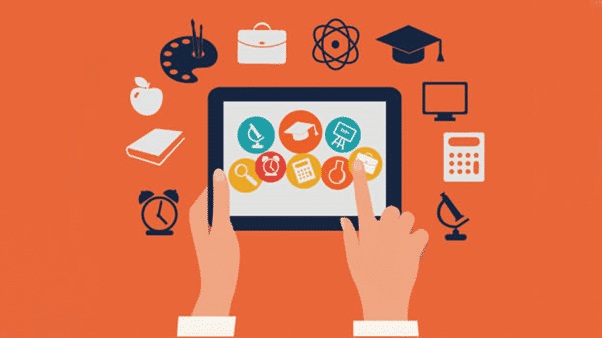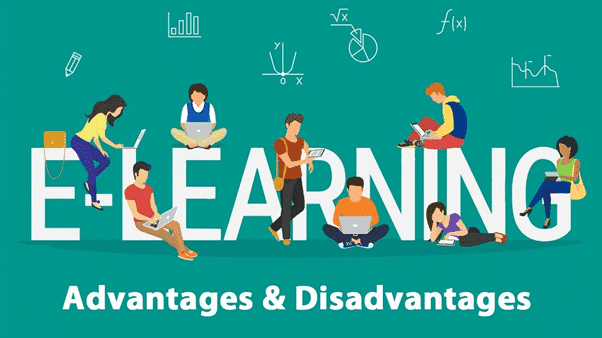With the onset of the fourth industrial revolution, it is impossible to imagine our world without the involvement of technology. As the nature of learning is evolving with the changing needs of time, so is the usage of technology in implementing it using various E-learning devices or methods.
Today online learning has made flexible learning possible with the use of various learning styles like microlearning, adaptive learning, virtual or augmented learning. Online learning is the way of the future as it offers significant benefits for educators and students.
What is e-Learning?
E-learning refers to learning and teaching of any kind supported by digital communication, electronic devices, or the internet.
What is the role of e-Learning in Education?

The role of E-Learning educational technology has helped to improve learning skills among students. The teachers are able to focus their energies on pedagogical functionality. Also, the ability of teachers to automate marking, digitally issue tests and track student progress with reporting tools and analytics makes the education landscape a more accommodating and innovative industry that puts students first.
It also encourages them to explore and learn ahead of the curriculum in a way that makes learning functional, relevant to today’s growing role of technology, and fun.
Features of e-Learning:
- We can combine various online learning tools to suit the specific needs of the learner. For Example, we can combine self-guided and web-based video conferencing to make learning effective.
- Online reports of execution, commitment, and evaluations can be generated, and an e-learning appraisal score can be obtained to achieve an ideal result.
- We can do brand integration and grow the online student client base.
- Students can self-register and pay according to their preferences.
- It can be used worldwide, Students can access eLearning courses anytime, anywhere.
- Online course catalogs can be created to provide ample choices for online students to choose with the click of a button.
- Easy to understand the design of these online courses makes it user-friendly.
- It is easy to use and instinctive.
- The collaboration of various learning tools. Mixed learning tools enable us to meet diverse learning needs and inclinations.
- Web-based business support: e-commerce coordination can be done to market e-learning courses.
What is the Purpose of e-learning?
We need e-Learning to fulfill the following requirements
- The purpose of e-learning is to make it convenient for the user to access information anytime, anywhere.
- The e-learning tools are also helpful in tracking the progress of students. Digital online learning has helped to better manage the process of teaching and learning, as we can measure the learning outcome and impact.
- The e-learning material can be designed to suit the interests and learning requirements of students.
- E-learning is global. It can adapt to any environmental changes. Also, it is flexible
- E-learning can effectively integrate others with digital mediums of knowledge to address all the needs of learners.
- The purpose of e-learning is to change the way students and teachers manage their progress in learning.
- Depending on the strategic goals and needs of students, the right e-learning solution can be found. This is more useful in case students need to learn the same skills.
Types of e-Learning
The concept of E-learning can be well understood with Synchronous and asynchronous types of learning methodology
Synchronous: With improved technology and good bandwidth, the student and teachers are online and interact at the same time from different locations. They deliver and receive the learning resources via mobile, video conference, Internet, or chat. Also, they can share their ideas during the session and interact with each other.
They can also use tools like a virtual classroom platform, audio and video conferencing, chat, webinar, application sharing, and messaging instantly.

Asynchronous: It is a student-directed, self-paced learning, pause-and-resume kind of learning. In this, the learner and the teacher cannot be online at the same time. It also requires the use of technologies such as email, blogs, discussion forums, eBook CDs, DVDs, etc., downloading documents, and chatting with teachers & also with co-learners without affecting their daily commitments.
Now we have an overview of what e-Learning is. Let’s discuss in detail the Advantages and Disadvantages of E-Learning devices for Children.
Advantages and Disadvantages of E-Learning
Advantages of e-Learning
#1 Saves Time
Students can access eLearning material anytime they want, and anywhere they are, setting their own pace and training whenever they have spare time and focus on learning what they actually need. Also, they don’t need to travel to their training events or stay after work to engage in training, and this is the main purpose of e-learning

#2 Cost-Effective
There is no need for a professional trainer who will deliver it and it will help students improve their knowledge and skills. It requires only online training software. Maximum engagement and knowledge retention. Students can include games and quizzes, and activities that enable real-time feedback that is helpful for them to grow and improve.
#3 Improved Efficiency
Students can train at home, in their free time, which will lead to better performance and higher efficiency, especially because online eLearning software will enable them to revisit any information they need, whenever they need it, and it is one of the main advantages of e-learning for students.
#4 Better Collaboration
Every online learning software provides useful communication and collaboration tools, which are essential for knowledge improvement and building a strong collaborative workforce, which will lead to increased engagement and a comfortable and empowering learning environment.
Good engagement can effectively address everyone’s strengths and weaknesses, and deal with skill gaps so that learners can improve their skills and abilities.

#5 Outreach / Access
Perhaps the most valuable benefit of e-learning is that it provides access to a wider audience. Through cloud computing and the Internet, institutions can offer training tools to employees anytime, anywhere.
#6 Low cost:
It’s a relatively low-cost method. E-learning doesn’t require paying an instructor, or space for training, and they don’t have to buy any new equipment or books.
#7 Ease of use
By choosing a user-friendly platform, institutions can count on their employees being able to navigate their way around and learn how to use it quickly while balancing multiple tasks, workloads, and deadlines. Learners can link the various resources in several varying formats. Everyone who is are part-time students or are working full time, can also take advantage of web-based learning. Web-based learning promotes active and independent learning.

Through discussion boards and chats, we are able to interact with everyone online and also clear doubts if any. Also, the video instructions that are provided for audio and video learning can be rewound and seen and heard again and again if we do not happen to understand the topic the first time around.
#8 Individual Pace
Online learning solutions provide much-needed effectiveness for teachers, allowing them to maximize the potential for individual learning curves and styles within the classroom
#9 Application of Theory
Now more than ever, children, youth, and students are accessing information and news online. They are also communicating, sharing, and exchanging ideas and concepts via technology through multimedia, video, chat, and interactivity.
#10 Practicality
The practical benefits to teachers can be measured in terms of time-based efforts and workload reduction. It allows teachers to quickly create tests and quizzes using a pre-existing or ever-expanding question bank. It permits the automation of marking those tests and quizzes. Practical benefits also include the ability to track the submission of digital assignments and reuse or reconstruct a course curriculum using new course templates.
#11 Access to Training
It helps students in learning with e-learning resources as a means of updating and honing one’s approach to constantly up the game, in turn making skill development a daily activity.
#12 Cloud Computing
The anytime-anywhere accessibility of information stored in remote cloud servers of the apps made it possible to access courseware and educational materials from any device and from anywhere. Virtual Reality and Augmented Reality have come as a big boost to online education. Also, this has led to good student engagement, traction, and learning output.
Through discussion boards and chats, we are able to interact with everyone online and also clear your doubts if any.
The video instructions that are provided for audio and video learning can be rewound and seen and heard again and again if you do not happen to understand the topic the first time around.
Disadvantages of e-Learning

#1. In developing countries, people do not have access to high-speed internet access trained IT personnel. Also, depending on the country or the area, even stable access to electrical power is scarce.
#2. Since every student is different so the material may need frequent updating as per the needs of students.
Note: To avoid such issues, it is important to make the right choice of digital online study tool.
Recent Trends in E-Learning
E-learning has undergone a rapid transformation in recent years, driven by technological advancements and the increased adoption of digital education tools. The COVID-19 pandemic further accelerated this shift, making online learning an essential part of mainstream education. Schools, universities, and corporate training programs have embraced digital platforms that offer interactive lessons, AI-driven personalized learning, and virtual classrooms. With mobile devices becoming more powerful and internet access expanding, students can now learn anytime and anywhere, breaking traditional classroom barriers. Additionally, the rise of gamification and immersive technologies like AR/VR is making e-learning more engaging and effective. These trends indicate that digital education is here to stay, reshaping the way we acquire knowledge.
Impact on Student Engagement
E-learning devices have significantly altered how students engage with educational content, offering both advantages and challenges. On the positive side, digital tools provide interactive and personalized learning experiences, catering to different learning styles through multimedia content, quizzes, and real-time feedback. Adaptive learning platforms analyze student performance and tailor lessons accordingly, keeping learners motivated. However, the same devices that enhance engagement can also lead to distractions, as students may find themselves tempted by social media, gaming, or non-educational content. Unlike traditional classrooms, where teachers can monitor students closely, online learning requires greater self-discipline. To maximize engagement, educators need to implement strategies such as structured lesson plans, interactive assignments, and parental controls for younger learners.
Technological Challenges
While e-learning devices provide convenience and flexibility, they also come with technical challenges that can impact the learning experience. One of the biggest hurdles is internet connectivity—students in rural or underprivileged areas may struggle with unstable or slow internet, making it difficult to access online lessons. Additionally, not all students have access to high-quality devices, with outdated or incompatible hardware limiting their ability to participate effectively in digital learning. Software issues, such as glitches in educational apps or compatibility problems, can also disrupt lessons and lead to frustration. Educators and institutions must address these challenges by ensuring that learning platforms are optimized for various devices and by providing offline learning options where necessary. Governments and private organizations are also stepping in to bridge the digital divide, making technology more accessible for all learners.
Final Word
The high-tech approaches have changed the entire traditional approach to education. In simple words, technology has provided teachers and learners with a new and enhanced way of interacting during the learning process. Technology also has a profound impact on today’s youth.
The advantages of using eLearning devices for students are so many that we can easily ignore the disadvantages if we use our discretion to make the right choice.
Last Update on 31st March 2025.

